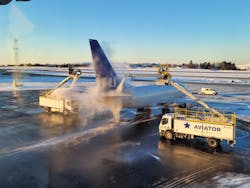Best Practices for Safe and Eco-Friendly Aviation Operations
As the winter season approaches, ground handling personnel in the aviation industry gear up for a challenging period. The winter aviation season demands heightened vigilance, close collaboration and adherence to specific guidelines and procedures. Ten essential aspects of preparing for winter aviation operations are explained by Anders H. Søreide, head of deice and safety advisor for Aviator Airport Alliance, a full-range provider of aviation services at 15 airports across the Nordics.
1. Ensuring Safe Operations During Winter Aviation Season
Winter operations require our staff to be more vigilant. Colder temperatures, weather, and wind all affect how we operate. Close collaboration with airport authorities and airlines is important. Most airlines and airports have specific winter operations guidelines and procedures. Ground handling personnel need to observe weather forecasts and conditions throughout the day and consider this when planning operations. With winter comes slippery surfaces and poor visibility. Our staff must drive and act accordingly. Warmer clothing is advisable as well (preferably wool).
2. Maintaining Ground Support Equipment (GSE) in Cold Weather
Second, maintaining ground support equipment (GSE) in cold weather is the key to preventing breakdowns of ground support equipment. GSE should ideally be stored inside a heated hangar when not in use. The winter season can lead to increased wear and tear due to temperature fluctuations, humidity, frost, and ice. If indoor storage is not an option, frequent inspections and proper outdoor storage in sheltered areas are essential. Equipping GSE with covers to protect control panels and ensuring appropriate tires can also enhance operability. Tools like brooms, ice scrapers, and snow blowers are handy for removing snow and ice from GSE. This is important to another aspect—ensuring ground staff well-being in icy and snowy conditions.
3. Ensuring Ground Staff Well-being in Icy and Snowy Conditions
Protecting the well-being of ground staff during icy and snowy conditions requires several measures. Adequate clothing is crucial to keep staff warm. Providing access to hot beverages, like coffee, can help staff stay comfortable and alert. Supportive management plays a pivotal role in understanding the challenges posed by winter conditions, as snow, ice, and cold temperatures can lead to delays and stress. It is essential to prioritize safety and acknowledge that weather conditions are beyond anyone's control.
4. Types of Deicing Fluids and Their Benefits
Deicing fluids are critical in Deice operations. It is important to distinguish between Deicing and Winter Operations. De/Anti-icing operations (incl. fluids) are specific only to De/Anti-icing operations. It is a stand-alone service, performed by dedicated, trained staff and is strictly regulated.
There are different types of Deicing fluids that play a critical role in winter aviation operations. There are several types of deicing fluids based on what is normally utilized in the Nordics explains Søreide, including:
Deicing fluids, which can be Hot water or Type 1 fluid/water mixture (Orange color). This melts and removes contaminants from the aircraft.
Anti-icing fluids, which can be Type 1 fluid/water mix or Type 2/ 4 (green/yellow in color), protect the surface of the aircraft from freezing.
Type 1,2 and 4 fluids are all glycol-based. Type 2 and 4 are often used undiluted and cold in the Nordics. Fluid types are selected based on prevailing weather and type of contamination. For anti-icing purposes, Type 1 provides a relatively short protection time while Type 2 and 4 are thicker and provides longer protection.
5. Impact of Temperature, Humidity, and Precipitation on De/Anti-icing Operations
The fifth aspect to be aware of during the winter season is the impact of temperature, humidity, and precipitation on de/anti-icing operations. De/Anti-icing operations are highly sensitive to prevailing weather conditions and aircraft status. Strict procedures and regulations are in place to determine whether an aircraft requires de/anti-icing and the appropriate method to use. Collaboration between ground handlers and aircraft commanders is essential to make informed decisions based on these factors.
6. Preventing Aircraft Surfaces from Refreezing After De/Anti-icing
De/Anti-icing is typically performed shortly before departure, providing a time-limited protection from refreezing de/anti-icing fluids are designed to flow off aircraft surfaces at certain speeds. If takeoff is delayed beyond the protection's time limit, a new de/anti-icing procedure must be conducted to ensure safety.
7. Aircraft-Specific Deicing and Anti-Icing Procedures
Different types of aircraft, including turboprops, wide-body planes, and regional jets, have specific deicing and anti-icing procedures outlined in their manuals and airline protocols. These procedures ensure that each aircraft type receives the appropriate treatment.
8. Prioritizing Aircraft During De/Antiiicing Fluid Shortages
Since de/anti-icing services are critical for flight safety, most larger service providers have backup agreements with other companies to ensure fluid availability. Thorough planning and collaboration between service providers, airport authorities and airlines are key.
9. Regulatory Compliance in Deicing Operations
The ninth aspect to be aware of during the winter season is that deicing operations are subject to strict regulations to ensure flight safety. No aircraft may take off with contamination on critical surfaces. Procedures and staff training adhere to standards set by SAE (Society of Automotive Engineers) and relevant national authorities, which may vary by region.
10. Eco-Friendly Practices in Deicing
The final aspect to address is the eco-friendly practices in Deicing. Addressing environmental concerns is an ongoing priority for the aviation industry. Several eco-friendly measures are being explored, including fluid reduction, manual contaminant removal, and electrically driven equipment. The challenge is to find sustainable solutions without compromising flight safety.
In conclusion, preparing for the winter aviation season involves comprehensive planning, meticulous attention to safety and efforts to minimize the environmental impact. Ground handling personnel, equipment, and deicing procedures are crucial elements in ensuring safe and efficient winter operations in the aviation industry.
Preparation for the winter aviation season, with a primary focus on deicing, is crucial for the safety and efficiency of operations. Ground handling personnel must remain vigilant, collaborate effectively, protect ground support equipment, prioritize staff well-being, and adhere to regulatory guidelines while exploring eco-friendly options.
